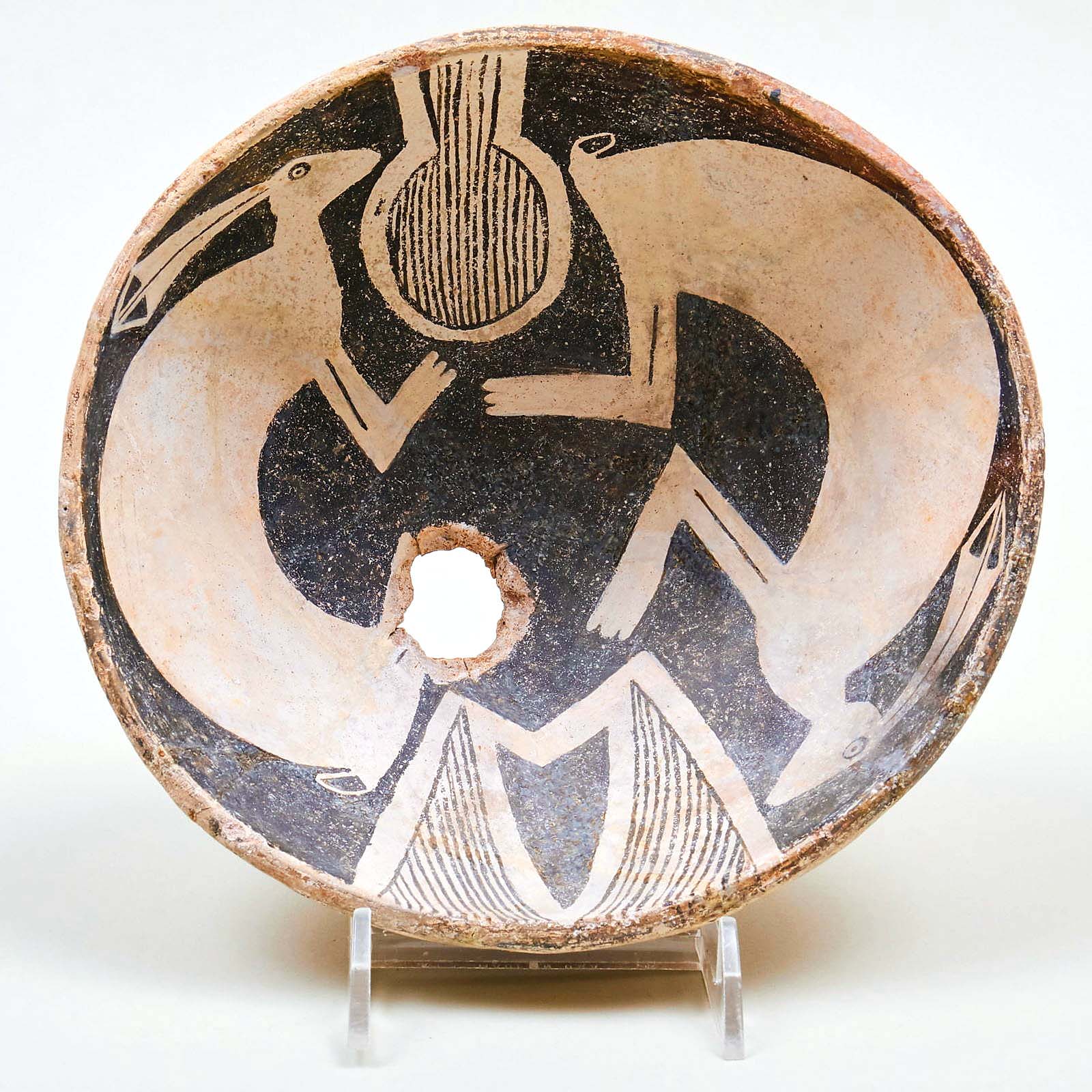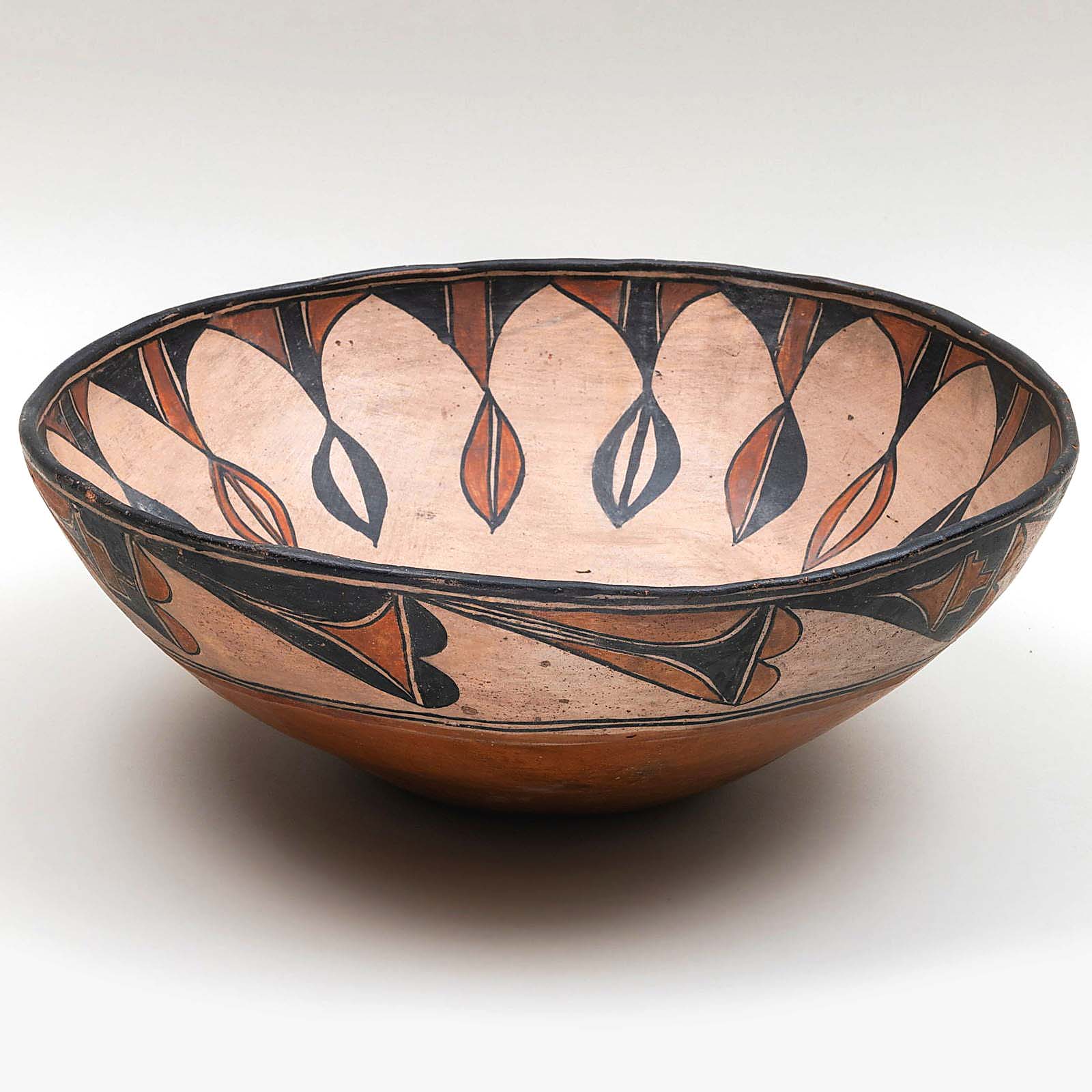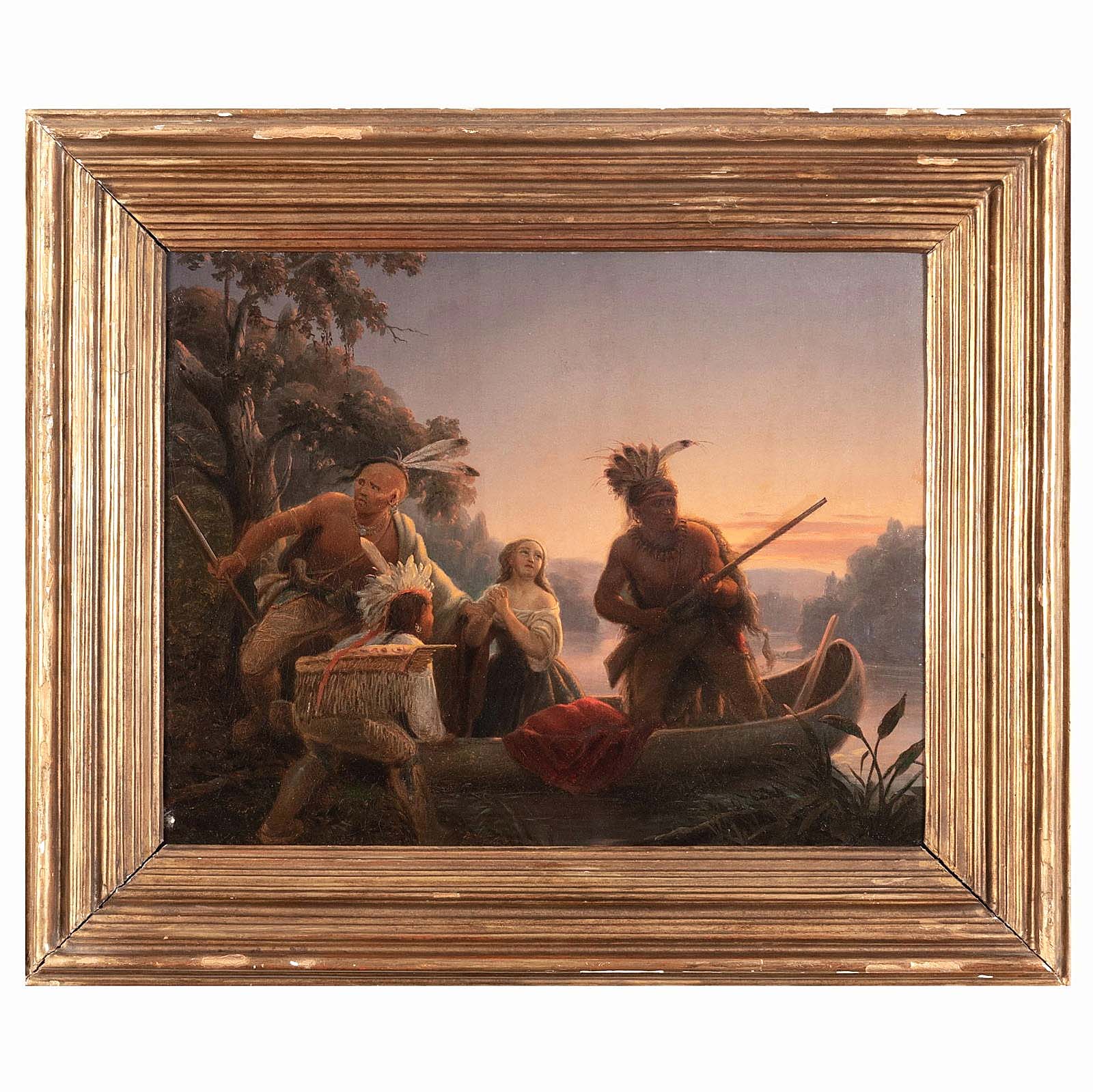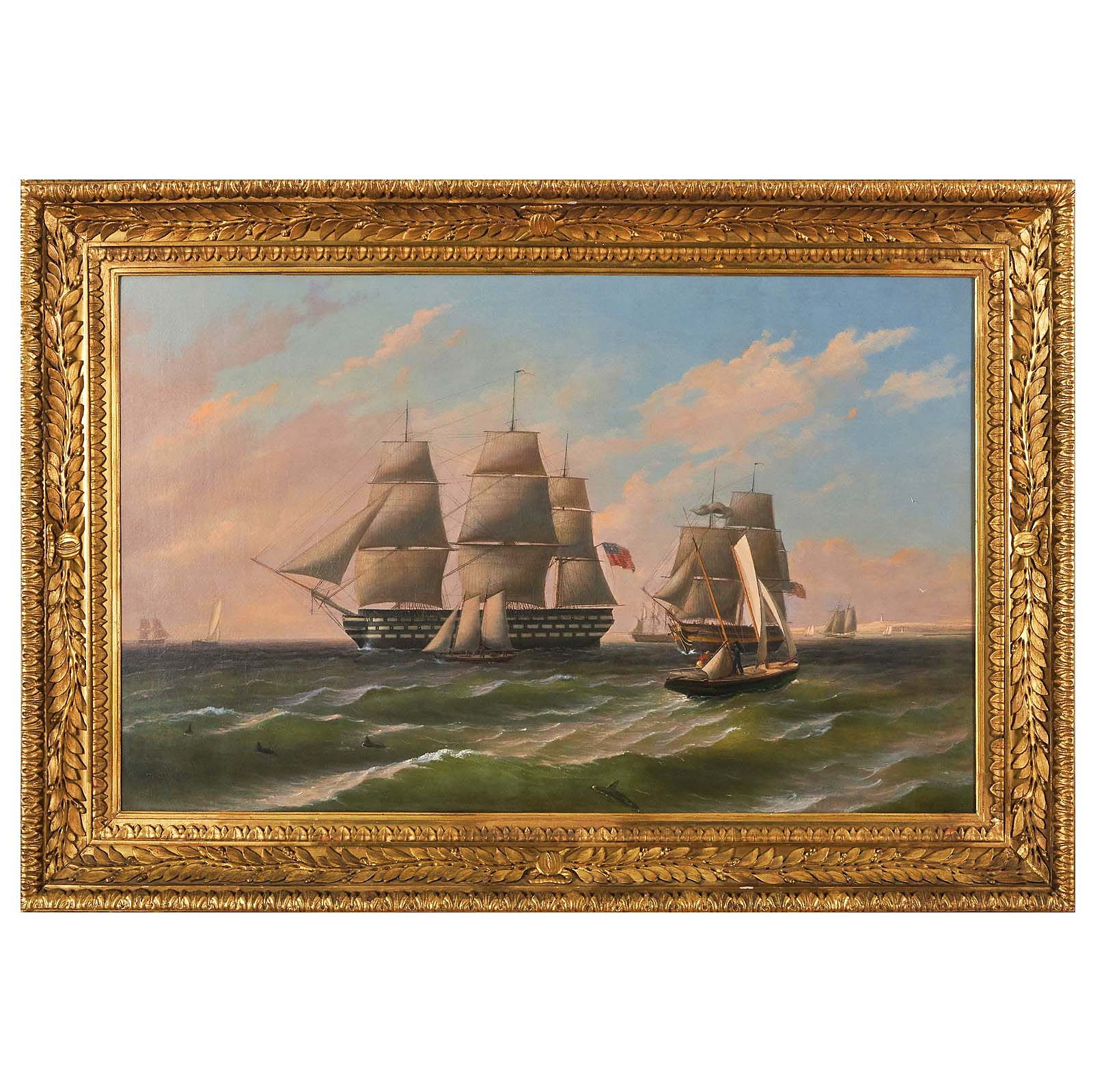#American #Art #Artifacts #Raise #Banner #Stair #Antiques #Arts #Weekly
Review by Carly Timpson
HUDSON, N.Y. — Across two days of auctions on July 31 and August 1, Stair Galleries presented nearly 500 lots of North American art and antiques with a total realized of $780,608 across both sales.
Indigenous Arts of North America

This chief’s second phase wearing blanket, possibly Navajo, 5 feet 3 inches by 4 feet 2 inches, was the highest-earning lot of the Indigenous Arts auction. It sold to a South Carolina collector for $11,520 ($5/7,000).
On July 31, the Indigenous Arts of North America auction presented 205 lots that “embody the sophisticated aesthetic sensibility of Native artists and artisans combined with their technical mastery of pottery, basketry, weaving and other Native arts.” With a 98 percent sell-through rate, the auction realized $187,488. Muffie Cunningham, Stair’s director of decorative arts said, “The indigenous sale was a little on the soft side but it’s a smaller market with not a lot of new collectors. All but two of the top lots sold to private collectors, the exceptions sold to the trade.”
Many of the works featured in this sale came from the collection of Gordon and Zanne Stewart, which was amassed over decades and represented their interest in multiple collecting categories. Stair released an informative statement about the Stewarts and their collection, writing, “Their mid-century home was decorated with furniture and objects from the same period, complemented by Asian and ethnographic ceramics and sculpture, Old Master, modern and contemporary art, Navajo rugs, pottery and books.”
From the Stewart collection, the sale’s top lot was a chief’s second phase wearing blanket, which was possibly Navajo in origin. The two outer bands and a matching central band were red with a stepped blue stripe in the middle. Cunningham noted, “This blanket was in very good condition. Because these blankets were utilitarian, most had wear and damage. The Stewarts took great care of it and kept it in great condition.” A South Carolina collector wrapped up the bidding for the piece at $11,520.

This 7¼-inch-wide Mimbres black and white pottery bowl with a rabbit motif had some losses including a hole to the base, was restored and inpainted but still did well; it was bid well beyond its estimate to $5,760 ($700/900).
Despite a significant hole through its bottom, bidders took a black-on-white Mimbres pottery bowl to $5,760 — more than six times its high estimate. According to Archaeology Southwest (Tucson, Ariz.), “The Mimbres region includes southwestern New Mexico and adjacent areas in Arizona and northern Mexico” and the Mimbres culture flourished between the years 1000 and 1130 CE. Decorated with twin rabbit motifs, the bowl was restored and had some inpainting but was in good condition otherwise. It had previously been in the Stewart collection and that of Gene Lang from Littleton, Colo.
Another Mimbres black and white bowl, also with a hole at its base, sold to a New Jersey collector for $3,712 ($500/700). This one, measuring 3 inches high by 7¼ inches in diameter, had abstract designs, a central fish motif and shared the same Lang to Stuart provenance. Given its age, it was considered to be in good condition despite the hole, cracks and other wear and losses.
Cunningham remarked, “The bowls have universal appeal. The shapes and designs are very attractive to many, even modern collectors and designers. These bowls were beautifully shaped, designed and crafted to be used in their regular lives, and its really impressive that they survived so long, especially considering all that the Natives had to face.”

A trade buyer claimed this San Ildefonso polychrome pottery dough bowl, 5¾ by 16 inches, for $4,480 ($1,5/2,000).
Other forms that did well were dough bowls. One from the San Ildefonso Pueblo, New Mexico, was 16 inches in diameter and had black and red details on white slip. It had provenance to the Primitive and Folk Art Laboratory, Denver, Colo., before joining the Stewart collection. More than doubling its high estimate, it was purchased by a trade buyer located in Arizona for $4,480. A Zuni (Zuni River Valley, New Mexico/Arizona) dough bowl with a quatrefoil interior design and zigzag stepped exterior designs sold to a trade buyer located in Connecticut for $4,160. It was incised on the bottom “4/255/F” and was formerly in the collection of Dewey Galleries, Ltd., in Santa Fe, N.M.
A large pottery olla, or storage jar, from the Cochití Pueblo in New Mexico also exceeded estimates to earn $5,120. With white slip and black and red painted decoration, the bulbous jar closely resembled an example with a similar pattern that is in the collection of the Museum of Fine Arts, Boston. The example in the sale was paired with a woven ring base and sold to a collector in Indiana.
The only object in the top 10 lots to not come from the Stewart collection was another olla. This one was from the Pueblo of Acoma (New Mexico) and was decorated with deer and flower motifs. After soaring past its $800 high estimate, a Connecticut buyer knocked it down for $4,800.
Two Navajo Germantown wearing blankets – styles which were predominantly crafted between 1864 and 1910 – from the Stewart collection had top-ten finishes. One, a bright red blanket with black and white crosses, was formerly in the collection of Terry DeWald, Tucson, Ariz. A California buyer cast the winning bid of $4,160. The other was a third phase chief’s blanket with black, white and gray stripes and gray cross accents; it went out to a Kentucky bidder for $3,840.
Americana at Stair

Earning the highest price overall and leading the Americana auction was “The Abduction of Daniel Boone’s Daughter” by Charles Wimar (German-American, 1828-1862). The circa 1853 oil on canvas work measured 21 by 25 inches framed and sold to a Kentucky buyer for $52,480 ($40/60,000).
The Americana at Stair auction on August 1 brought forth 287 lots “celebrating the history and diversity of the United States,” including furniture, folk art and decorations. Exceeding the sale’s overall high estimate with 91 percent of lots sold, the auction realized $593,120. “I would definitely call this sale a success for us,” commented Cunningham.
The highest price — $52,480 — was achieved by “The Abduction of Daniel Boone’s Daughter,” an oil painting by German-born Charles Ferdinand Wimar (1828-1862). According to the auction catalog, “Wimar was fascinated by the American frontier, and in particular by the conflict between Native Americans and Western settlers. The theme of captivity and abduction of white settlers by Native Americans was widely portrayed in fine art and literature at this time, helping to justify and glorify the colonization of the American West.” In this circa 1853 painting, he depicted several Natives holding young Jemima Boone — whose hands are folded together in prayer — captive in a canoe by the Kentucky River.
From the estate of Richard P. Mellon, an environmental philanthropist, was “The Everglades Club,” an oil painting by Ralph Eugene Cahoon Jr. Signed “R. Cahoon” to the lower right, this folky work depicted three well-dressed men seated around a table on the waterfront deck of The Everglades Club. Serving the men were four topless mermaid waitresses, each wearing a uniform hat and pearl body jewelry. A buyer from New York City claimed the painting for $35,840, more than double its high estimate, though, according to Cunningham, they plan to donate the work to the Palm Beach, Fla., social club it depicts.

Achieving $32,000 was “Western Landscape” by Albert Bierstadt (German-American, 1830-1902), oil on paper on canvas, 18½ by 23½ inches framed; it sold to a trade buyer ($15/20,000).
Albert Bierstadt’s “Western Landscape” also surpassed its estimates, selling to a trade buyer for $32,000. “Western Landscape” was previously owned by Carolyn Amory of New York, who bought the work in 1969 under the impression that it was an oil on canvas painting, only to later discover that it was done on paper and matted on canvas. The work, which was erroneously identified as Yosemite by Newhouse Galleries in the 1960s, actually depicted a Utah landscape, according to Melissa Webster Speidel of the Albert Bierstadt Catalogue Raisonné Project. Cunningham shared that the trade buyer was located in Utah, joyously saying, “It’s going back to where it was painted!”
Thomas Chambers’ “Indiaman Saluting at the Island of St Helena,” which had a high estimate of just $8,000, sold to an Illinois buyer for $25,600. It was previously exhibited in the De Young Museum’s 1986-87 (San Francisco, Calif.) “American Folk Art: A Sampling from Northern California Collections” exhibition and had another label from The Denver Art Museum (Denver, Colo.). Additionally, Kathleen A. Foster included an illustration of this work in her book, Thomas Chambers: American Marine and Landscape Painter, 1808-1869 (Philadelphia: Philadelphia Museum of Art, 2008). Despite scattered inpainting and craquelure, bidders took a liking to the cliffside harbor scene, and it was quickly driven up in price.
More ships were present on the seas in “Harbor View,” an American school painting signed “T. Birch.” The oil on canvas work featured a couple of tall ships surrounded by smaller vessels, with a small pod of dolphins cresting the water in the lower left quadrant. While the artist was unknown to Stair, bidders enjoyed the view and took it two-times higher than its estimate, with a trade buyer in Connecticut placing the winning bid of $8,320.

An American school oil on canvas painting, titled “Harbor View,” signed “T. Birch” and measuring 33½ by 48½ inches framed, sold to a trade buyer for $8,320 ($2/4,000).
Edward Sheriff Curtis, photographer and documenter of Native American people and culture, was well-represented in this sale. His haunting orotone photograph “The Vanishing Race” was bid well past its $5,000 estimate to sell to a New Jersey collector for $15,360. The photograph was taken in 1904 as part of his The North American Indian project and it was said to represent the vanishing of indigenous peoples, with the subjects facing away from the camera and riding on horseback into the shadows of the setting sun. Two bound volumes of The North American Indian, numbers XII (1922) and XVII (1926) of 40 total volumes, sold together to a trade buyer in Colorado for $8,320. Volume XII was rebound but the original leather was included with the set.
“Unbeknownst to us, it was an incredibly rare piece of American furniture, and it sold to the trade in New York,” Cunningham said of an unusual cherry wood candlestand. The piece came from the collection of Hudson Valley auctioneer, Cal Smith, and was in good overall condition. Since little was known about the candlestand, Stair had its high estimate at just $700; bidders proved its worth, taking it to $8,320.
While the majority of bidders in both of the auctions — around 95 to 98 percent, according to Cunningham — were based in the United States, Cunningham noted international interest in “an absolutely enormous service” of Gorham sterling silver flatware. Comprising 357 pieces in total, the service was in the Versailles pattern with monogrammed handles and was housed in a wooden storage chest. A dealer based in India, who was a new client for Stair, won the set for $15,360. Cunningham said, “The sheer volume really helped drive the bidding.”
Prices quoted include the buyer’s premium as reported by the auction house. Stair will be auctioning fine art and antiques from the Lyme, Conn., estate of Henri Charles Veit on September 11. For information, www.stairgalleries.com or 518-751-1000.




